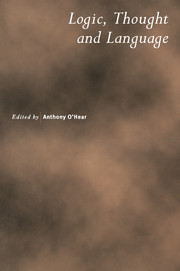Book contents
- Frontmatter
- Contents
- Preface
- Notes on Contributors
- What logic should we think with?
- Mental Representation and Mental Presentation
- Self-knowledge, Normativity, and Construction
- The Normativity of Meaning
- Two Theories of Names
- Relativism and Classical Logic
- Principles for Possibilia
- What are these Familiar Words Doing Here?
- Particular Thoughts & Singular Thought
- Conditional Belief and the Ramsey Test
- Necessary Existents
- Ambiguity and Belief
- Basic Logical Knowledge
- Frege's Target
- Index
What are these Familiar Words Doing Here?
Published online by Cambridge University Press: 05 October 2010
- Frontmatter
- Contents
- Preface
- Notes on Contributors
- What logic should we think with?
- Mental Representation and Mental Presentation
- Self-knowledge, Normativity, and Construction
- The Normativity of Meaning
- Two Theories of Names
- Relativism and Classical Logic
- Principles for Possibilia
- What are these Familiar Words Doing Here?
- Particular Thoughts & Singular Thought
- Conditional Belief and the Ramsey Test
- Necessary Existents
- Ambiguity and Belief
- Basic Logical Knowledge
- Frege's Target
- Index
Summary
My title is a quotation from Davidson's essay ‘On Saying That’. And although my concerns are at some remove from his, they do connect at one significant point. We (non-philosophers as well as philosophers) find ourselves under the continual pressure of theory to deny that ordinary familiar semantic features of ordinary familiar words equip them to serve certain ordinary familiar functions. One of Davidson's aims is to resist that pressure as far as the function of reporting indirect speech is concerned. In similar vein I want to look at some common things that we do with words and show how we can hold fast to a simple common-sense view of what we are doing despite the doubts to which reflection is apt to give rise. In fact I want to look at six things we do with words, six linguistic moves we make. These six moves are related in a number of important ways. Even so, they are really the subjects of six separate essays (six separate sketchy essays at that), and I am well aware that treating them together in the way that I shall be doing—worse still, trying thereby to make some headway with solving one or two extremely difficult philosophical problems, as I shall also be doing—will mean that in each case I can at best produce something highly programmatic.
- Type
- Chapter
- Information
- Logic, Thought and Language , pp. 147 - 172Publisher: Cambridge University PressPrint publication year: 2002

